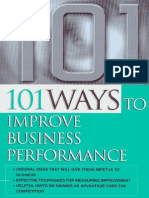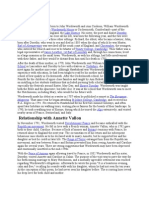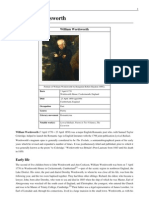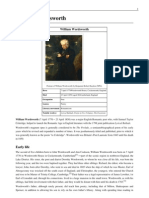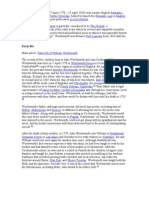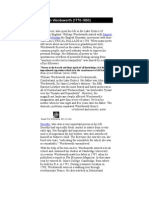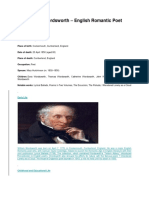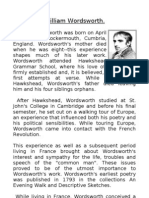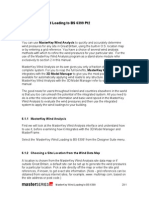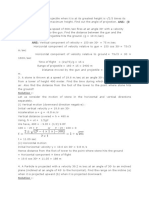Relationship With Annette Vallon: The European Magazine
Relationship With Annette Vallon: The European Magazine
Uploaded by
Jahnavi SinghCopyright:
Available Formats
Relationship With Annette Vallon: The European Magazine
Relationship With Annette Vallon: The European Magazine
Uploaded by
Jahnavi SinghOriginal Description:
Original Title
Copyright
Available Formats
Share this document
Did you find this document useful?
Is this content inappropriate?
Copyright:
Available Formats
Relationship With Annette Vallon: The European Magazine
Relationship With Annette Vallon: The European Magazine
Uploaded by
Jahnavi SinghCopyright:
Available Formats
he second of five children born to John Wordsworth and Ann Cookson, William Wordsworth was born on 7 April 1770
in Wordsworth House in Cockermouth, Cumberland[1]part of the scenic region in northwest England, theLake District. His sister, the poet and diarist Dorothy Wordsworth, to whom he was close all his life, was born the following year, and the two were baptised together. They had three other siblings: Richard, the eldest, who became a lawyer; John, born after Dorothy, who went to sea and died in 1805 when the ship of which he was Master, the Earl of Abergavenny, was wrecked off the south coast of England; and Christopher, the youngest, who entered the Church and rose to be Master of Trinity College, Cambridge.[2] Their father was a legal representative of James Lowther, 1st Earl of Lonsdale and, through his connections, lived in a large mansion in the small town. Wordsworth, as with his siblings, had little involvement with their father, and they would be distant from him until his death in 1783. [3] Wordsworth's father, although frequently away from home on business, encouraged him in his reading, and in particular set him to commit to memory large portions of poetry, including that of Milton, Shakespeare and Spenser; in addition William was allowed to use his father's library. Along with spending time reading in Cockermouth, Wordsworth would also stay at his mother's parents' house in Penrith, Cumberland. At Penrith, Wordsworth was exposed to the moors. Wordsworth could not get along with his grandparents and his uncle, and his hostile interactions with them distressed him to the point of contemplating suicide.[4] After the death of their mother, in 1778, Wordsworth's father sent him to Hawkshead Grammar School in Lancashire (now in Cumbria) and Dorothy to live with relatives in Yorkshire; she and Wordsworth would not meet again for another nine years. Although Hawkshead was Wordsworth's first serious experience with education, he had been taught to read by his mother and had attended a tiny school of low quality in Cockermouth. After the Cockermouth school, he was sent to a school in Penrith for the children of upper-class families and taught by Ann Birkett, a woman who insisted on instilling in her students traditions that included pursuing both scholarly and local activities, especially the festivals around Easter, May Day, and Shrove Tuesday. Wordsworth was taught both the Bible and theSpectator, but little else. It was at the school that Wordsworth was to meet the Hutchinsons, including Mary, who would be his future wife.[5] Wordsworth made his debut as a writer in 1787 when he published a sonnet in The European Magazine. That same year he began attending St John's College, Cambridge, and received his B.A. degree in 1791.[6] He returned to Hawkshead for his first two summer holidays, and often spent later holidays on walking tours, visiting places famous for the beauty of their landscape. In 1790, he took a walking tour of Europe, during which he toured the Alps extensively, and visited nearby areas of France, Switzerland, and Italy.
Relationship with Annette Vallon[edit]
In November 1791, Wordsworth visited Revolutionary France and became enthralled with the Republican movement. He fell in love with a French woman, Annette Vallon, who in 1792 gave birth to their child, Caroline. Because of lack of money and Britain's tensions with France, he returned alone to England the next year. [7]The circumstances of his return and his subsequent behaviour raise doubts as to his declared wish to marry Annette, but he supported her and his daughter as best he could in later life. The Reign of Terror estranged him from the Republican movement, and war between France and Britain prevented him from seeing Annette and Caroline again for several years. With the Peace of Amiens again allowing travel to France, in 1802 Wordsworth and his sister, Dorothy, visited Annette and Caroline in Calais. The purpose of the visit was to pave the way for his forthcoming marriage to Mary Hutchinson.[7] Afterwards he wrote the sonnet "It is a beauteous evening, calm and free" recalling a seaside walk with the 9 year old Caroline he had never seen prior to that visit. The sonnet is somewhat reserved but it is plain Wordsworth felt genuine affection for his daughter, as indeed did Mary who was anxious that Wordsworth should do more for Caroline should their circumstances improve. Her wish was granted at Caroline's marriage in 1816, when Wordsworth settled 30 annually on Caroline, a generous allowance (1,360 purchasing power in year 2000 pounds sterling) that continued until 1835, when it was replaced by a capital settlement. [8][9]
In his "Preface to Lyrical Ballads", which is called the "manifesto" of English Romantic criticism, Wordsworth calls his poems "experimental." The year 1793 saw Wordsworth's first published poetry with the collections An Evening Walkand Descriptive Sketches. He received a legacy of 900 from Raisley Calvert in 1795 so that he could pursue writing poetry. That year, he met Samuel Taylor Coleridge in Somerset. The two poets quickly developed a close friendship. In 1797, Wordsworth and his sister Dorothy moved to Alfoxton House, Somerset, just a few miles away from Coleridge's home in Nether Stowey. Together, Wordsworth and Coleridge (with insights from Dorothy) produced Lyrical Ballads (1798), an important work in the English Romantic movement. The volume gave neither Wordsworth's nor Coleridge's name as author. One of Wordsworth's most famous poems, "Tintern Abbey", was published in the work, along with Coleridge's "The Rime of the Ancient Mariner". The second edition, published in 1800, had only Wordsworth listed as the author, and included a preface to the poems, which was augmented significantly in the 1802 edition. This Preface to Lyrical Ballads is considered a central work of Romantic literary theory. In it, Wordsworth discusses what he sees as the elements of a new type of poetry, one based on the "real language of men" and which avoids the poetic diction of much 18th-century poetry. Here, Wordsworth gives his famous definition of poetry as "the spontaneous overflow of powerful feelings: it takes its origin from emotion recollected in tranquility." A fourth and final edition of Lyrical Ballads was published in 1805.
The Borderers[edit]
From 1795 to 1797, he wrote his only play, The Borderers, a verse tragedy set during the reign of King Henry III of England when Englishmen of the north country were in conflict with Scottish rovers. Wordsworth attempted to get the play staged in November 1797, but it was rejected by Thomas Harris, manager of Covent Garden Theatre, who proclaimed it "impossible that the play should succeed in the representation". The rebuff was not received lightly by Wordsworth, and the play was not published until 1842, after substantial revision. [11]
Germany and move to the Lake District[edit]
Wordsworth, Dorothy and Coleridge travelled to Germany in the autumn of 1798. While Coleridge was intellectually stimulated by the trip, its main effect on Wordsworth was to produce homesickness.[7] During the harsh winter of 179899, Wordsworth lived with Dorothy in Goslar, and, despite extreme stress and loneliness, he began work on an autobiographical piece later titled The Prelude. He wrote a number of famous poems, including "The Lucy poems". He and his sister moved back to England, now to Dove Cottage in Grasmere in the Lake District, and this time with fellow poet Robert Southey nearby. Wordsworth, Coleridge and Southey came to be known as the "Lake Poets".[12] Through this period, many of his poems revolve around themes of death, endurance, separation and grief.
Marriage and children[edit]
In 1802, Lowther's heir, William Lowther, 1st Earl of Lonsdale, paid the 4,000 debt owed to Wordsworth's father incurred through Lowther's failure to pay his aide. [13] It was this repayment that afforded Wordsworth the financial means to marry, and on 4 October, following his visit with Dorothy to France to arrange matters with Annette, Wordsworth married a childhood friend, Mary Hutchinson.[7] Dorothy continued to live with the couple and grew close to Mary. The following year, Mary gave birth to the first of five children, three of whom predeceased William and Mary:
John Wordsworth (18 June 1803 1875). Married four times: 1. 2. 3. 4. Isabella Curwen (d. 1848) had six children: Jane, Henry, William, John, Charles and Edward. Helen Ross (d. 1854). No children Mary Ann Dolan (d. after 1858) had one daughter Dora (b. 1858). Mary Gamble. No children
Dora Wordsworth (16 August 1804 9 July 1847). Married Edward Quillinan in 1843. Thomas Wordsworth (15 June 1806 1 December 1812).
Catherine Wordsworth (6 September 1808 4 June 1812). William "Willy" Wordsworth (12 May 1810 1883). Married Fanny Graham and had four children: Mary Louisa, William, Reginald, Gordon.
Autobiographical work and Poems in Two Volumes[edit]
Wordsworth had for years been making plans to write a long philosophical poem in three parts, which he intended to call The Recluse. He had in 179899 started an autobiographical poem, which he never named but called the "poem to Coleridge", which would serve as an appendix to The Recluse. In 1804, he began expanding this autobiographical work, having decided to make it a prologue rather than an appendix to the larger work he planned. By 1805, he had completed it, but refused to publish such a personal work until he had completed the whole of The Recluse. The death of his brother John, in 1805, affected him strongly. The source of Wordsworth's philosophical allegiances as articulated in The Prelude and in such shorter works as "Lines written a few miles above Tintern Abbey" has been the source of much critical debate. While it had long been supposed that Wordsworth relied chiefly on Coleridge for philosophical guidance, more recent scholarship has suggested that Wordsworth's ideas may have been formed years before he and Coleridge became friends in the mid-1790s. While in Revolutionary Paris in 1792, the 22-year-old Wordsworth made the acquaintance of the mysterious traveller John "Walking" Stewart (17471822),[14] who was nearing the end of a thirty-years' peregrination from Madras, India, through Persia and Arabia, across Africa and all of Europe, and up through the fledgling United States. By the time of their association, Stewart had published an ambitious work of original materialist philosophy entitled The Apocalypse of Nature(London, 1791), to which many of Wordsworth's philosophical sentiments are likely indebted. In 1807, his Poems in Two Volumes was published, including "Ode: Intimations of Immortality from Recollections of Early Childhood". Up to this point Wordsworth was known publicly only for Lyrical Ballads, and he hoped this collection would cement his reputation. Its reception was lukewarm, however. For a time (starting in 1810), Wordsworth and Coleridge were estranged over the latter's opium addiction. [7] Two of his children, Thomas and Catherine, died in 1812. The following year, he received an appointment as Distributor of Stamps for Westmorland, and the 400 per year income from the post made him financially secure. His family, including Dorothy, moved to Rydal Mount, Ambleside (between Grasmere and Rydal Water) in 1813, where he spent the rest of his life. [7]
The Prospectus[edit]
In 1814, he published The Excursion as the second part of the three-part The Recluse. He had not completed the first and third parts, and never would. He did, however, write a poetic Prospectus to "The Recluse" in which he lays out the structure and intent of the poem. The Prospectus contains some of Wordsworth's most famous lines on the relation between the human mind and nature: My voice proclaims How exquisitely the individual Mind (And the progressive powers perhaps no less Of the whole species) to the external World Is fitted:and how exquisitely, too, Theme this but little heard of among Men, The external World is fitted to the Mind. Some modern critics[who?] recognise a decline in his works beginning around the mid-1810s. But this decline was perhaps more a change in his lifestyle and beliefs, since most of the issues that characterise his early poetry (loss, death, endurance, separation and abandonment) were resolved in his writings. But, by 1820, he enjoyed the success accompanying a reversal in the contemporary critical opinion of his earlier works. Following the death of his friend the
painterWilliam Green in 1823, Wordsworth mended relations with Coleridge. [15] The two were fully reconciled by 1828, when they toured the Rhineland together.[7]Dorothy suffered from a severe illness in 1829 that rendered her an invalid for the remainder of her life. In 1835, Wordsworth gave Annette and Caroline the money they needed for support.
The Poet Laureate and other honours[edit]
Wordsworth received an honorary Doctor of Civil Law degree in 1838 from Durham University, and the same honour from Oxford University the next year.[7] In 1842, the government awarded him a civil list pension amounting to 300 a year. With the death in 1843 of Robert Southey, Wordsworth became the Poet Laureate. He initially refused the honour, saying he was too old, but accepted when Prime Minister Robert Peel assured him "you shall have nothing required of you". He became the only laureate to write no official poetry. When his daughter, Dora, died in 1847, his production of poetry came to a standstill.
Death[edit]
Gravestone of William Wordsworth,Grasmere, Cumbria
William Wordsworth died by aggravating a case of pleurisy on 23 April 1850, and was buried at St. Oswald's church inGrasmere. His widow Mary published his lengthy autobiographical "poem to Coleridge" as The Prelude several months after his death. Though this failed to arouse great interest in 1850, it has since come to be recognised as his masterpiece.
Major works[edit]
Lyrical Ballads, with a Few Other Poems (1798)
"Simon Lee" "We are Seven" "Lines Written in Early Spring" "Expostulation and Reply" "The Tables Turned"
"The Thorn" "Lines Composed A Few Miles above Tintern Abbey"
Lyrical Ballads, with Other Poems (1800) Preface to the Lyrical Ballads "Strange fits of passion have I known"[16] "She Dwelt among the Untrodden Ways"[16] "Three years she grew"[16] "A Slumber Did my Spirit Seal"[16] "I travelled among unknown men"[16] "Lucy Gray" "The Two April Mornings" "Nutting" "The Ruined Cottage" "Michael" "The Kitten At Play"
Poems, in Two Volumes (1807) "Resolution and Independence" "I Wandered Lonely as a Cloud" Also known as "Daffodils" "My Heart Leaps Up" "Ode: Intimations of Immortality" "Ode to Duty" "The Solitary Reaper" "Elegiac Stanzas" "Composed upon Westminster Bridge, September 3, 1802" "London, 1802" "The World Is Too Much with Us"
Guide to the Lakes (1810) " To the Cuckoo " The Excursion (1814) Laodamia (1815, 1845) The Prelude (1850)
You might also like
- KTN100 KTN100-212 PDFDocument55 pagesKTN100 KTN100-212 PDFsugeda100% (3)
- Astm e 2930 - 13Document8 pagesAstm e 2930 - 13Martin Chimenti - ARO SA100% (1)
- Haas Creamer 2006 Crucible of Andean CivilizationDocument31 pagesHaas Creamer 2006 Crucible of Andean CivilizationScott JacksonNo ratings yet
- 101 Ways To Improve Business PerformanceDocument153 pages101 Ways To Improve Business Performancetegolino_s100% (3)
- Relationship With Annette Vallon : Earl of AbergavennyDocument7 pagesRelationship With Annette Vallon : Earl of AbergavennyAnanyaNo ratings yet
- William WordsworthDocument10 pagesWilliam WordsworthJatinChadhaNo ratings yet
- Early Life: The European MagazineDocument5 pagesEarly Life: The European MagazineSanyam JainNo ratings yet
- William WordworthDocument9 pagesWilliam WordworthroxanapopoviciNo ratings yet
- William WordsworthDocument9 pagesWilliam WordsworthPranav PunjabiNo ratings yet
- William Wordsworth - WikipediaDocument19 pagesWilliam Wordsworth - WikipediaizmsherNo ratings yet
- William Words WorthDocument9 pagesWilliam Words WorthNishat HaiderNo ratings yet
- William Wordsworth (7 April 1770 - 23 April 1850) Was A Major EnglishDocument5 pagesWilliam Wordsworth (7 April 1770 - 23 April 1850) Was A Major EnglishShinoy SebastianNo ratings yet
- William Wordsworth - WikipediaDocument74 pagesWilliam Wordsworth - WikipediamohammedaakifansariNo ratings yet
- William WordsworthDocument13 pagesWilliam Wordsworthjeykumar29902990No ratings yet
- William Wordsworth - WikipediaDocument20 pagesWilliam Wordsworth - WikipediaAmritNo ratings yet
- Early Life: Lyrical Ballads The PreludeDocument2 pagesEarly Life: Lyrical Ballads The PreludePranay BansalNo ratings yet
- Composed Upon West Minster Bridge AnalysisDocument15 pagesComposed Upon West Minster Bridge AnalysisEfi Puspitasari100% (1)
- William Wordsworth - WikipediaDocument14 pagesWilliam Wordsworth - WikipediaIlakkia MariNo ratings yet
- William Wordsworth English Romantic PoetDocument2 pagesWilliam Wordsworth English Romantic Poetrajesh0005No ratings yet
- William Wordsworth - WikipediaDocument21 pagesWilliam Wordsworth - WikipediaSrijal sharmaNo ratings yet
- A Comparative Study Between Wordsworth and Coleridge FinalDocument89 pagesA Comparative Study Between Wordsworth and Coleridge FinalSharifMahmud75% (4)
- William Words WorthDocument9 pagesWilliam Words WorthShayan SikanderNo ratings yet
- Week 10 William Wordsworth PoemsDocument5 pagesWeek 10 William Wordsworth Poemsminhduongqntt2No ratings yet
- William Wordsworth: William Wordsworth (1770-1850), British Poet, Credited With Ushering in The EnglishDocument2 pagesWilliam Wordsworth: William Wordsworth (1770-1850), British Poet, Credited With Ushering in The EnglishMINo ratings yet
- William Wordsworth Biography: García Gabriel. Parodi Roland. Quintero JoséDocument8 pagesWilliam Wordsworth Biography: García Gabriel. Parodi Roland. Quintero JoséRocilena RodriguezNo ratings yet
- William Words Worth. HistoryDocument18 pagesWilliam Words Worth. HistoryArchna KhareNo ratings yet
- Biography On Williams WordsworthDocument7 pagesBiography On Williams Wordsworthhumayunameer.7001No ratings yet
- Wordsworth, William (1770-1850), English Poet, One of The MostDocument3 pagesWordsworth, William (1770-1850), English Poet, One of The MostAkash NeogiNo ratings yet
- Biography On Williams WordsworthDocument7 pagesBiography On Williams Wordsworthhumayunameer.7001No ratings yet
- VickyDocument2 pagesVickyhai_173No ratings yet
- WordsworthDocument3 pagesWordsworthnikithaNo ratings yet
- William WordsworthDocument2 pagesWilliam WordsworthShavel Kumar0% (1)
- William Words WorthDocument18 pagesWilliam Words WorthUsama100% (7)
- William WordsworthDocument2 pagesWilliam WordsworthSadia100% (1)
- Preface To Lyrical BalladsDocument24 pagesPreface To Lyrical BalladsAli Abbas100% (1)
- William Wordsworth BiographyDocument2 pagesWilliam Wordsworth BiographyMelanie100% (3)
- William Wordsworth BiographyDocument4 pagesWilliam Wordsworth BiographyAbid HussainNo ratings yet
- William Wordsworth: Romantic PoetryDocument34 pagesWilliam Wordsworth: Romantic PoetryMà Ř YãmNo ratings yet
- William Wordsworth (1770-1850) : Wordsworth Was One of The Most Influential of England's Romantic PoetsDocument1 pageWilliam Wordsworth (1770-1850) : Wordsworth Was One of The Most Influential of England's Romantic PoetsArdhendu MaityNo ratings yet
- William Wordsworth WikipediaDocument1 pageWilliam Wordsworth WikipediaRocky KingNo ratings yet
- Untitled DocumentDocument1 pageUntitled DocumentyoanachukovaNo ratings yet
- Wordsworth TimelineDocument27 pagesWordsworth TimelineKaushik RayNo ratings yet
- Biography of William WordsworthDocument1 pageBiography of William WordsworthJo GutierrezNo ratings yet
- William Words Worth Was Born April 7Document4 pagesWilliam Words Worth Was Born April 7MorikeHutagalungNo ratings yet
- William Wordsworth - PoemDocument11 pagesWilliam Wordsworth - PoemFuifNo ratings yet
- Wordsworth BiographyDocument3 pagesWordsworth BiographySabahNo ratings yet
- Study Guide to the Major Poetry of William WordsworthFrom EverandStudy Guide to the Major Poetry of William WordsworthNo ratings yet
- William Wordsworth - English Romantic PoetDocument5 pagesWilliam Wordsworth - English Romantic PoetShouban JatoiNo ratings yet
- William Wordsworth 2Document43 pagesWilliam Wordsworth 2sherry3719qaoNo ratings yet
- HarshDocument3 pagesHarshKeyur ThakarNo ratings yet
- Biography of William WordsworthDocument3 pagesBiography of William WordsworthLeoNo ratings yet
- William Wordsworth: Lyrical Ballads (1798) - The Collection, Which Contained Wordsworth's "Tintern Abbey"Document2 pagesWilliam Wordsworth: Lyrical Ballads (1798) - The Collection, Which Contained Wordsworth's "Tintern Abbey"Amalia HaniNo ratings yet
- Leigh Hunt and William Wordsworth 2 Poets InformationDocument2 pagesLeigh Hunt and William Wordsworth 2 Poets InformationjasujunkNo ratings yet
- William Wordsworth: Life and WorksDocument6 pagesWilliam Wordsworth: Life and Worksشروق محسن مفرود طحمNo ratings yet
- The Prelude by Wordsworth 5254uiDocument983 pagesThe Prelude by Wordsworth 5254uimisobod8No ratings yet
- DaffodilsDocument78 pagesDaffodilsTúc BạchNo ratings yet
- William WordsworthDocument1 pageWilliam WordsworthJeliegh Gasmin100% (1)
- (Penguin Classics) William Wordsworth - The Prelude (2010, Penguin Group) - Libgen - LiDocument961 pages(Penguin Classics) William Wordsworth - The Prelude (2010, Penguin Group) - Libgen - LiAndos FrodyNo ratings yet
- William Wordsworth Life and PoemsDocument14 pagesWilliam Wordsworth Life and Poemskyawswar100% (1)
- William Words WorthDocument4 pagesWilliam Words WorthMuhammad Tahir100% (1)
- (Cliffs Notes) M. A. Warren Paul - Cliffsnotes The Prelude (2001, Hungry Minds) - Libgen - LiDocument44 pages(Cliffs Notes) M. A. Warren Paul - Cliffsnotes The Prelude (2001, Hungry Minds) - Libgen - LiAndos FrodyNo ratings yet
- The Walt Disney CompanyDocument30 pagesThe Walt Disney CompanyJahnavi Singh100% (1)
- The Fourth World: Maroon 5 (Formerly Kara's Flowers) Is An AmericanDocument8 pagesThe Fourth World: Maroon 5 (Formerly Kara's Flowers) Is An AmericanJahnavi SinghNo ratings yet
- Football: Football Refers To A Number ofDocument29 pagesFootball: Football Refers To A Number ofJahnavi SinghNo ratings yet
- Birla Institute of Technology and ScienceDocument20 pagesBirla Institute of Technology and ScienceJahnavi SinghNo ratings yet
- Bansal Tutorials Pvt. LTD, 65, Kalu Sarai, Sarvapriya Vihar, Hauz Khas, New Delhi - 16 PH: 41828700Document8 pagesBansal Tutorials Pvt. LTD, 65, Kalu Sarai, Sarvapriya Vihar, Hauz Khas, New Delhi - 16 PH: 41828700Garvit GoyalNo ratings yet
- Well, So It Goes Lyk I'Ve Sort of Planned To Write My Dairy . SO 2DAY'S 29 NOVEMBER 2009 .Document5 pagesWell, So It Goes Lyk I'Ve Sort of Planned To Write My Dairy . SO 2DAY'S 29 NOVEMBER 2009 .Jahnavi SinghNo ratings yet
- Enrique IglesiasDocument12 pagesEnrique IglesiasJahnavi SinghNo ratings yet
- 7th Heaven: Jessica Claire (Biel) Timberlake (Born March 3, 1982)Document10 pages7th Heaven: Jessica Claire (Biel) Timberlake (Born March 3, 1982)Jahnavi SinghNo ratings yet
- Justin Randall TimberlakeDocument26 pagesJustin Randall TimberlakeJahnavi SinghNo ratings yet
- For You A 1000 Times OverDocument1 pageFor You A 1000 Times OverJahnavi SinghNo ratings yet
- Advancing Vocabulary SkillsDocument11 pagesAdvancing Vocabulary SkillsDamaris LambrightNo ratings yet
- Mybatis TutorialDocument69 pagesMybatis TutorialOvidiu Costinel DanciuNo ratings yet
- 6 SanctificationDocument4 pages6 SanctificationEdward Aldana100% (1)
- Just The UnusualDocument7 pagesJust The Unusualapi-497521634No ratings yet
- Vet Obst Lecture 4 Congenital Fetal Defects (Teratology)Document34 pagesVet Obst Lecture 4 Congenital Fetal Defects (Teratology)gnpobsNo ratings yet
- MasterKey Wind Loading To BS 6399Document31 pagesMasterKey Wind Loading To BS 6399colbm100% (1)
- Basic Accounting For Non-Accountants (A Bookkeeping Course)Document49 pagesBasic Accounting For Non-Accountants (A Bookkeeping Course)Diana mae agoncilloNo ratings yet
- Growing Flowers For SeniorsDocument113 pagesGrowing Flowers For SeniorsDon Redbrook0% (1)
- 115 East Furniture V Globe & Rutgers Fire, L-35848, 57 Phil 576 (1929)Document2 pages115 East Furniture V Globe & Rutgers Fire, L-35848, 57 Phil 576 (1929)Jovelan V. EscañoNo ratings yet
- Ilc Intro Pdftex03 03Document59 pagesIlc Intro Pdftex03 03KARKAR NORANo ratings yet
- Research ProposalDocument2 pagesResearch ProposalmohdportmanNo ratings yet
- Generation Gap Conflict in The Selected Short Stories of Nick JoaquinDocument9 pagesGeneration Gap Conflict in The Selected Short Stories of Nick JoaquinDanken Mathew P. TorresNo ratings yet
- Developing Effective Coping Strategies and Cpoing Skills and HabitsDocument2 pagesDeveloping Effective Coping Strategies and Cpoing Skills and HabitsTim StanleyNo ratings yet
- Pinchas, פִּינְחָסDocument6 pagesPinchas, פִּינְחָסDavid MathewsNo ratings yet
- Reaction PaperDocument3 pagesReaction PaperMichaella ArandiaNo ratings yet
- Dummy Subject ThereDocument1 pageDummy Subject ThereRoberto JrNo ratings yet
- GPRS ExplainedDocument11 pagesGPRS ExplainedAhmed Hamed BadrNo ratings yet
- Worksheet: Sue LeatherDocument3 pagesWorksheet: Sue LeatherKalicratesNo ratings yet
- TLCDDocument45 pagesTLCDmurudi murudiNo ratings yet
- The Speed of A Projectile When It Is at Its Greatest Height IsDocument2 pagesThe Speed of A Projectile When It Is at Its Greatest Height IsNandan AnnamrajuNo ratings yet
- Academiccalendar201922July PDFDocument7 pagesAcademiccalendar201922July PDFvishnuNo ratings yet
- General Health Profiling StudentsDocument1 pageGeneral Health Profiling StudentsMohammad Matte UllahNo ratings yet
- Accounting For ValueDocument15 pagesAccounting For ValuesankarNo ratings yet
- K Kishan V Vijay Nirman Company LTDDocument12 pagesK Kishan V Vijay Nirman Company LTDR100% (1)
- HOME-VISIT Sir DeoDocument26 pagesHOME-VISIT Sir DeoWilma Nierva BeraldeNo ratings yet
- B53-Matangi Mudra-08Document4 pagesB53-Matangi Mudra-08Lifes Liitle TricksNo ratings yet



